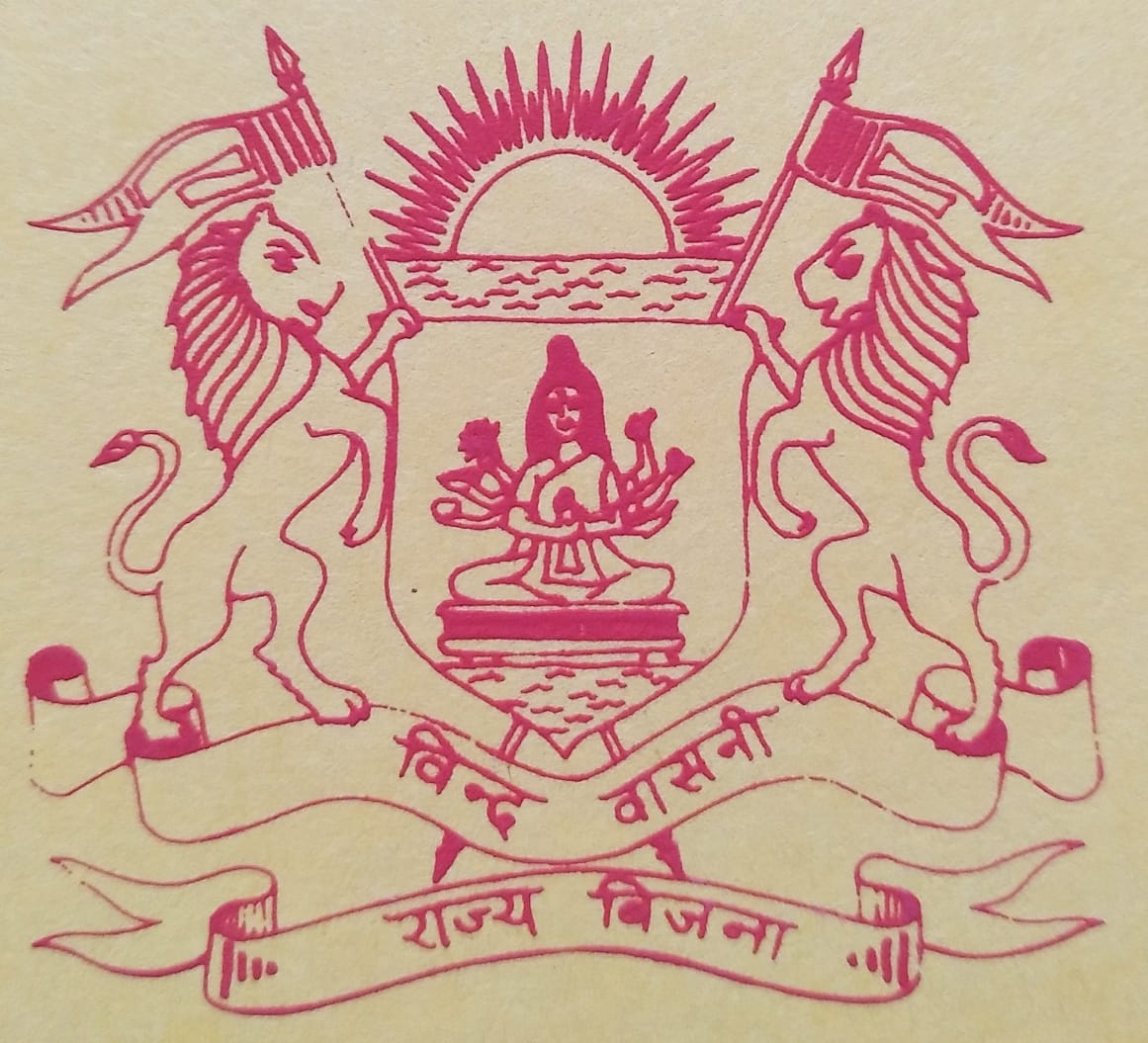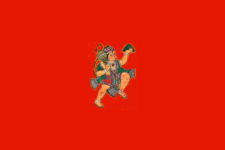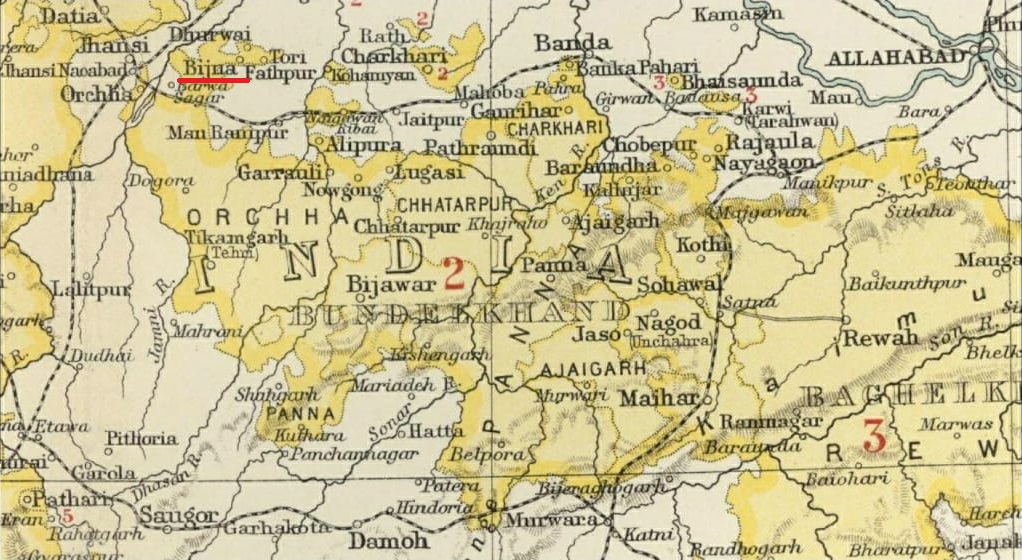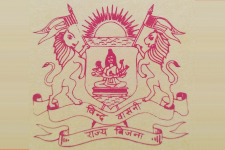



Bijna state in the imperial gazetteer of india
भारत के शाही राजपत्र में बिजना राज्य

Mahendra Raja Jaiveer Singh Ju Deo Bahadur
(Born - January 21st, 1978)
Raja of Bijna since 2003
married, Rani Bhawana Kumari of Panna (2nd December,2009)
and has issue, one son
Mahendra Rajkumar Lakshyaraj Singh Ju Deo Bahadur
(Born - December 17th, 2010)
(CE 1531-54) founder of Bijna
He succeeded the throne of orchha in 1554.
Born in Bijna Fort, Anand Bhawan
He succeeded the throne of orchha in 1592.
(Badagaon Branch - 1627)
(CE 1690-1752) 2nd founder of Bijna
He was granted the title of “Mahendra” by Padshah Alamgir - Jahangir.
He succeeded the throne of orchha in 1752 till 1765, after the death of maharaja prithvi singh of orchha.
He separated Bijna from orchha in 1765 and declared Bijna independent state.
Married and had issue, three sons
married and had issue, two son -
He succeeded the throne of orchha in 1775-1776
married and had issue, one daughter, one son
He succeeded the the throne of orchha in 1817-1834.
(CE 1765) Married and had issue, 19th sons
A kingdom is just as strong as it's king- wrote a wise, old philosopher. Raja Ajeet Singh exemplified it by administering his state, Bijna, capably. Being a wise king, he generously supported enterprising and intrepid soldiers, courtiers and subjects He put the fear of his sword in the hearts of marauding ravagers, despoilers and plundering dacoits, providing peace and stability in his State to the peasants and traders alike. During his reign Bijna prospered and progressed. He raised an army of his own. He meted out harsh punishment to those who proved to be treacherous or disloyal and thus earned the name of being despotic and authoritarian. Once his brother from Chirgaon sought his help in chasing off a troop of British soldiers who had camped on the border of Chirgaon and killed two pet white peacocks of the jagirdar. The British soldiers also threatened to attack Chirgaon. Raja Ajeet Singh left for Chirgaon with his army without delay, fought with the British troops and drove away the aggressors. Even the most valiant hesitsted to nettle the British troops, but Ajeet Singh refused to be intimidated by them. The people of Chirgaon still remember him for his valour and indomitable spirit.
Died - 1839
married and had issue, one son
Mahendra Raja Surjan Singh followed in his father's footsteps and judiciously maintained the kingdom established by him. A man of imposing personality and impressive physique, he governed the state astutely. His administrative and economic policies led to progress and development in the region. The hilly terrain of Bundelkhand was drought prone and had extreme climate. Braving these difficulties the Kings established kingdoms that lasted for centuries. Surjan Singh laid down stringent laws to check dacoiety and robbery in his state. He dealt strictly with those who broke the law. He provided protection to skilled and worthy traders, craftsmen, artisans and farmers. He piously preserved the time tested traditions of his great ancestors. He ruled wisely for eleven years.
Mahendra Raja Surjan Singh's brothers ascended the throne of Orchha when the royal line of Orchha ended without a successor. Raja Bharti Chand II ruled for a year from 1775 to 1776. A serious illness took his life and Orcha again adopted a King from Bijna, the younger brother of the deceased Raja Bharti Chand II. Raja Vikramajeet was crowned the King of Orchha and he ruled the State with great success for twenty one years, from 1776 to 1817. Vikramajeet had a daughter Kanchan ju raja and a son Rajkumar Dharampal who were both born in Bijna. During his reign he built the magificient Kanchan Mahal at Baldeogarh for his daughter, Princess Kanchan ju raja. He also constructed a smaller replica of Bijna Fort at Bhamori near Mowranipur. This fort was specifically built to keep the Reserve Army of Bijna. Both the monuments stand till date and bear a testimony to the contribution of Bijna in the development of Bundekhand.
Mahendra Raja Surjan Singh ju deo received the Grant (Sanad) of 16 sixteen villages from the British government in 11April 1823. Bijna, Basaar, Vijaygarh, Hanota, Bhagora, Dhawai, Majra, Bagroni, Ghanghari, Durbutiyao, Lathesara, Rajgir, Dadpura, Tai, Silohi, Huddiyan goan.
Died June, 1850
Raja of Bijna 1839-1850
married and had issue, one son
The history of Bundelkhand at the beginning of the 19th centuary is full of turmoil and wars. A famine also struck around 1830 causing great suffering and loss of human life.
Surjan Singh Ju Deo of Bijna was succeeded by his son, Mahendra Raja Durjan Singh ju Deo, also known as Khanderao. He dealt with the growing complexities of transient political powers and their struggles to gain supremacy with great foresight . The Marathas, the East India Company, the Mughals, the minor alien forces and the indigenous clans battled to overpower the weak and assert their authority. Mahendra Raja Durjan Singh maintained peace and tranquillity in his region during his reign from 1839 to 1850. He followed the systems laid down by his father . Under his able administration the people of Bijna survived the onslaught of nature and conflicting powers.
Born - 1838 - Died - 1908
Raja of Bijna - 1850-1908
married, had issue, 2 sons
married and had issue, 4 sons
He was excluded from the succession for administrative incompetence.
received Tai as Jagir from Bijna State in 1919
Mahendra Raja Mukund Singh ju Deo of Bijna ruled from 1858 to 1908. By this time the British Crown had taken over the power in its hands. In 1854 the Bundelkhand Agency was placed under the authority of Central India Agency, headquartered at Indore. British granted administrative powers to Mahendra Raja Mukund Singh ju Deo . He was to maintain 21cavalry, 150 infantry and 15 guns. He successfully maintained law and order in the region. He carried forward the most cherished traditions of his illustrious forefathers. At the same time he encouraged modern ideas among the common people.
(CE November 18th,1894-November 27th, 1955)
Raja of Bijna 1908-1955
He did two marriages
1. married, daughter of Thakur Barjor singh pawar (Thakur of katharvada in Charkhari)
2. married, daughter of Thakur Meharban singh pawar of Katili in Datia
And had issue, three sons and two daughters
(CE 1926-2009)
Received Bagroni as Jagir from Bijna State
Received Hanota as Jagir from Bijna State
After the turbulent years of freedom struggle all the States of India merged with the newly constituted nation, India, liberating themselves from the yoke of imperialist colonizers. The State of Bijna, held in the steady hands of Mahendra Raja Himmat Singh ju Deo Bundela steered itself through this storm with calm and fortitude. Himmat Singh ju deo had been trained to govern and administer the state from the tender age of ten when the then king of Bijna passed away. The British Political Agent turned down the claim made to the throne of Bijna by Mardan Singh, the younger brother of the deceased king as he was not able to read an English book. Himmat Singh ju Deo Bundela was educated in Nowgaon Maharaja School. He ascended the throne after the completion of his education in 1908. He was granted the additional title of 'Bahadur' by the British. He attended the Imperial Darbar in 1911 along with the King of Tori-Fatehpur. He was awarded a sword and two medals for personal distictinction. Till date people of Bijna remember him as an able administrator. He extended the area under cultivation, developed proper agricultural practices, negotiated with the British to construct canals, set up a flour mill, invited artisans and craftsmen, scholars and vaidyas, trained soldiers, constructed and restored the fort. He relentlessly strove to improve the State and its citizens. As a result of his efforts, Bijna acquired an enviable position in Bundelkhand. He embraced the modern ideas of education and economic development but at the same time retained the long standing social, cultural and religious traditions in place since times immemorial. He faced the dilemma of accepting or rejecting traditions at every step and with great sagacity took extremely tough decisions both at personal and public levels.
He educated his younger sons at the prestigious Scindia School in Gwalior, a public school for royal princes. His eldest son, Raja Chhatrapati Singh ju Deo, however immersed himself in music much against his father's will. Later as he grew proficient in his art and became a cynosure of musicians, Himmat Singh ju Deo half-heartedly relented, allowing him to pursue his passion and calling. Though he did not live to see his son achieve international and national fame as a Pakhawaj virtuoso.
(CE April 6th,1919-September 12th,1998)
Raja of Bijna - (1955-1998)
He did two marriages
1. daughter of Rao Sahib Shivapati singh pawar in Karahiya
2. daughter of Rao Sahib Durjan singh pawar in Garrauli
And had issue, one son and two daughters
Mahendra Raja Chhatrapati Singh ju Deo Bahadur descended from a long line of rulers who established several kingdoms in the mountainous terrain of Bundelkhand in northern Uttar Pradesh . He was the eldest son of Maharaja Himmat Singh Ju Deo Bahadur , the King of the erstwhile independent state of Bijna. He earned international acclaim by reviving and restoring the ancient art of Pakhawaj recital, a unique musical instrument of India. He achieved this feat by sheer will, discipline and perseverance. He took formal training from his Guru, Swami Ramdas Ji. By his efforts he became an A Grade artist at the All India Radio, Lucknow and performed regularly . In addition he accompanied Vocal artists for various stage performances at national and international level. He trained many young Indian and foreign artists in the classical guru-shishya tradition. He also wrote several books on the art of Pakhawaj recital. Not only did he preserve the classical taals and taal-cycles but also composed many new taals. He was a reincarnation of Lord Ganesha in his felicity of rendering the 'bols'. He also invented a taal- yantra. During his tour of Germany he established a world record by playing the Pakhawaj on stage for twelve hours. He was awarded The Sangeet Natak Academy Award by the President R. Venkataraman. He was invited by the Washington University as Professor of Music. His knowledge of classical music was pure, extensive and his rendition of Pakhwaj echoed with the divine 'naad'. He was one of those rare beings who not only are blessed by the Divine Muse but have a lifelong connect with Goddess Saraswati.
A Pakhawaj virtuoso, a consummate artist, an erudite music scholar, a creative writer, an out of the box inventor, an accomplished chess enthusiast, a dexterous wrestler and a visionary -were just some of the most remarkable aspects of Raja Saheb whose qualities were infinite.
(CE 1940-January 20th,2003)
Raja of Bijna - 1998-2003
Married, Rani Uma Kumari, daughter of Thakur Saheb Daulat Singh of Naila Thikana of Jaipur
And had issue, one son and one daughter
Mahendra Raja Surya Pratap Singh Ju Deo Bhahadur, was a charismatic and popular humanist who devoted his life to the upliftment of the poor and oppressed people of Bundelkhand, a drought ridden, Rocky terrain of UP. He advocated education as the key to progress. He travelled extensively in the remote interiors of Bundelkhand spreading modern ideas and battling ignorance and poverty. The only son of the renowned Pakhawaj Maestro, Raja Chhatrapati Singh Ju Deo Bhahadur, of Bijna State, he himself was a gifted sitar player and a tabla accompanist of no mean merit. He had so many qualities that an entire book could be devoted to him alone. A talented sportsman, a gifted musician, singer and lyricist and a music aficionado, an avid nature photographer, a knowledgeable person with wide reading interest, an expert shooter, an exceptional organizer and human resource manager, a spiritualist and deeply religious being, a devoted son, a loving and caring father and above all a magnanimous and generous human being with immense positive energy and optimism.